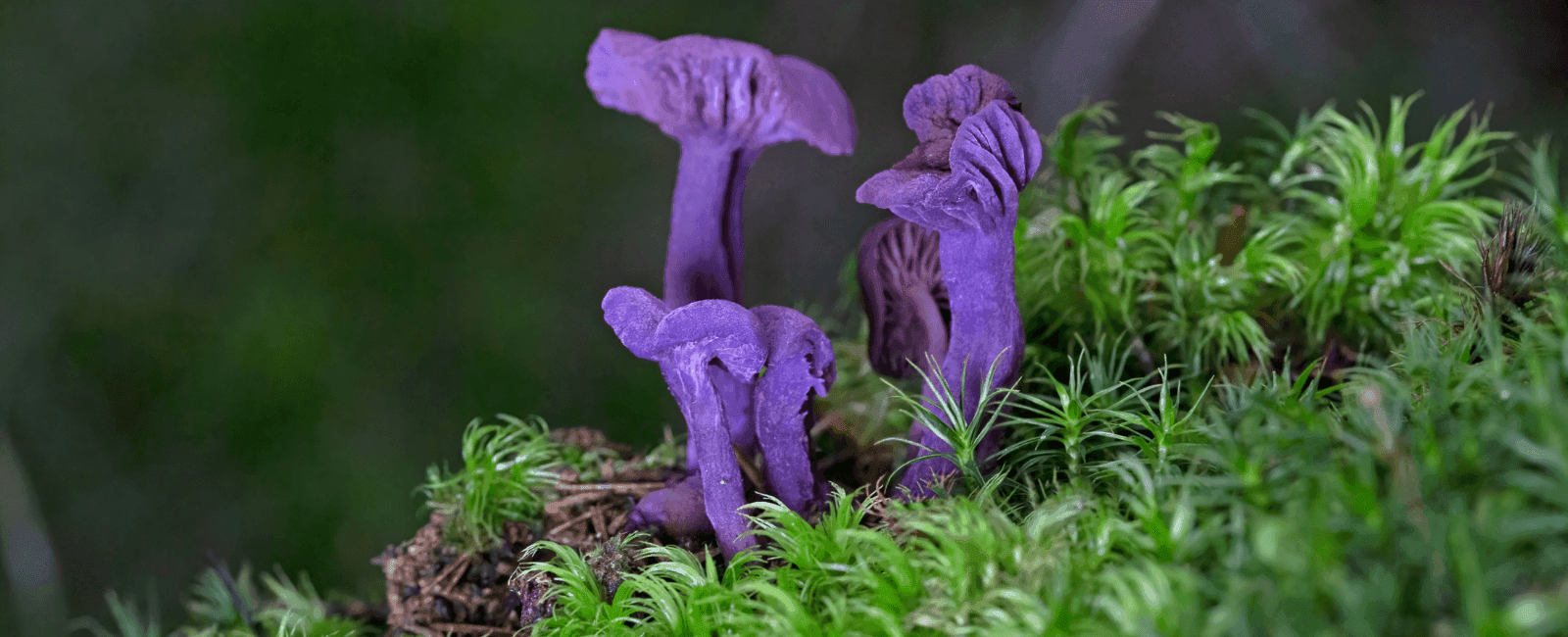

Walking through the grocery store produce section, one might assume that most mushrooms are beige, round, and smooth. But did you know that wild mushrooms actually come in a beautiful variety of colors? From fairytale-esque bright red and white, to deep moody blues, and even mushroom species that glow in the dark, the fungi world has an amazing spectrum of hues.
Similarly to plants, these colors serve the fungi various purposes, like attracting bugs that help disperse their spores. They can also be signals that the mushrooms are poisonous.
We’ve compiled this list of the most beautiful and colorful mushrooms in the fungi world, where to find them, and whether these stunning beauties are edible or deadly.
Fly Agaric mushroom
Scientific name: Amanita muscaria
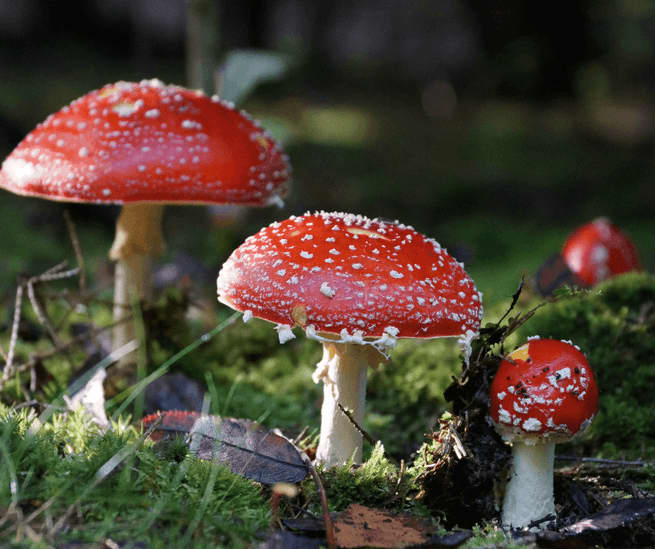
These are some of the most recognizable species found on many moist forest floors around the world, including the UK, New Zealand, and North America. They range from small mushrooms to large, usually found in bunches. Often called “toadstools,” they are commonly shown in fairy tale and cottagecore illustrations. The fly amanita was even the inspiration for the mushrooms in Mario Bros. However, don’t be fooled by their cute associations - these mushrooms are actually one of the most potent “magic mushrooms” and have extremely intense hallucinogenic properties.
Scarlet Cup mushroom
Scientific name: Sarcoscypha coccinea

These vibrant bright red mushrooms are unique in that they have a concave cup shape to their cap. This shape helps them send out puffs of spores to reproduce. You can find them on decomposing wood and leaf substrate on the forest floor. They are known to have a bitter beet-like flavor and are considered edible mushrooms. They’re found on six continents: Asia, Africa, Europe, North and South America, and Australia.
Bleeding Tooth fungus

Scientific name: Hydnellum peckii
The cap of this oozing, uniquely beautiful mushroom is dotted with red liquid drops known as guttation. This inedible fungus is native to coniferous forests in North America, especially the Pacific Northwest, and Europe. While they may look scary, they’re actually a great example of mycorrhizal fungi, or those that share a mutually beneficial relationship with the trees they grow near.
Orange Waxcap mushroom
Scientific name: Hygrocybe aurantiosplendens

There are over 150 species of hygrocybe that come in a variety of beautiful colors. They can be found in cooler environments on the forest floor. These bright-orange beauties may look tasty, yet their edibility remains uncertain. Because there are so many different types, correctly identifying the individual species can be difficult. It’s not recommended to eat orange waxcaps because, at their best, they are bland and unsubstantial, and at their worst, very toxic.
Wrinkly Peach mushroom
Scientific name: Rhodotus palmatus

These adorable mushrooms have rounded orange caps with a fibrous netted outer layer and look just like their name suggests! However, unlike their juicy fruit counterpart, these mushrooms are bitter, rubbery, and quite rare. This mushroom grows on rotting hardwood, specifically on elm, basswood, and maple.
Chicken of the Woods mushroom
Scientific name: Laetiporus sulphureus

This brightly-colored fungus definitely lives up to its name, as it tastes remarkably similar to chicken when properly cooked. Chicken of the woods is a great beginner foraging mushroom because of its distinct look, though be warned – some people experience gastrointestinal discomfort after eating this mushroom, so try a little taste first to see how your body will react. This fungus grows on oak, beech, and chestnut trees, but avoid any that grow on yew trees, as they can be toxic.
Golden Chanterelle mushroom
Scientific name: Cantharellus cibarius

Golden chanterelles are among the most sought edible mushrooms out there because of their unique flavor. Some describe it as peppery or slightly fruity. These mushrooms don’t only taste delicious but are also quite lovely if you run into a patch of them during one of your mushroom forays. Search for them in coniferous forest floors after a good rain.
Golden Oyster mushroom
Scientific name: Pleurotus citrinopileatus
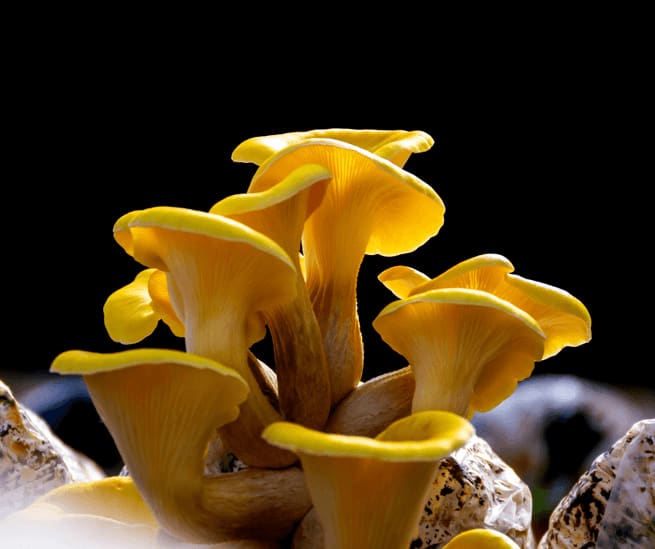
Oyster mushrooms are not only delicious but also come in a variety of different hues. They grow in the hardwood forests of Japan, Northern China, and Eastern Russia. Along with their excellent flavor and texture, oyster mushrooms have a plethora of nutritional benefits. In fact, golden oysters are higher in protein compared to other oyster mushroom varieties. If you’re foraging for this golden shroom, make sure to properly identify it, as there are many look-alikes that could be toxic.
Yellow Pholiota mushroom
Scientific name: Pholiota flammans

Aptly named in Latin (flammans means flaming), this shaggy yellow and orange mushroom looks like it has literally caught flame. With its tufts of scales on its cap, the Flaming Scalycap Mushroom is found near dead conifer stumps and often alone instead of formations. It’s been recorded across Europe, the U.S., India, and China.
Ghost fungus
Scientific name: Neonothopanus gardneri

The ghost fungus has a truly unique coloring - they actually glow in the dark at nighttime! While it is beautiful to see, it’s not just for aesthetics. This trait helps them attract bugs that disperse their spores after landing on the mushrooms. Although this glowing mushroom may be enticing to insects, the ghost mushroom should not be consumed by humans, as it is incredibly poisonous and deadly.This fungus is located in Australia and Tasmania, though similar glowing species can be found in North America.
Chicken Lips mushroom
Scientific name: Leotia viscosa
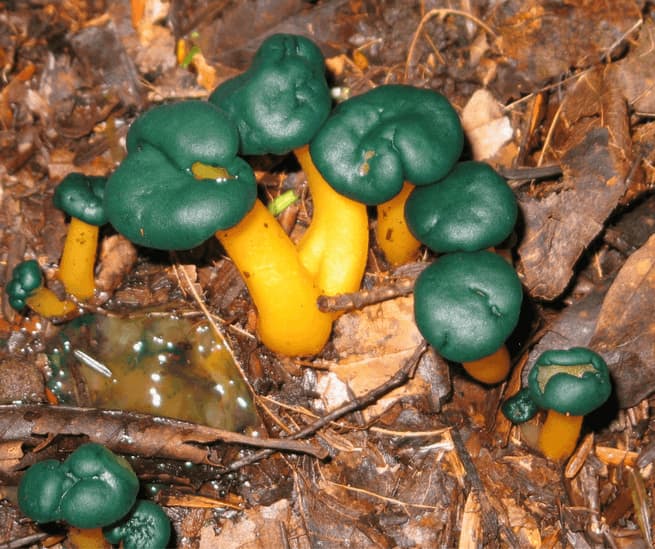
Image source: Carlmueller via Wikimedia Commons
With its humourous name and vibrant appearance, the chicken lips mushroom is an unforgettable foraging find. You can find these mushrooms growing under conifer trees or on decaying logs. Though apparently harmless, we don’t recommend trying this fungus due to inconclusive evidence of its edibility.
Parrot Waxcap mushroom
Scientific name: Gliophorus psittacinus

Though this is the second waxcap on this list, the parrot waxcap is actually not related to the orange waxcap. This mushroom was initially labeled as part of the Hygrocybe genus, though scientists later relabeled it under a different species. Regardless, this brilliantly green mushroom has a similar shiny, slimy cap. You can find them growing in grasslands during the early summer throughout Europe and eastern North America.
Werewere-Kōkako
Scientific name: Entoloma hochstetteri
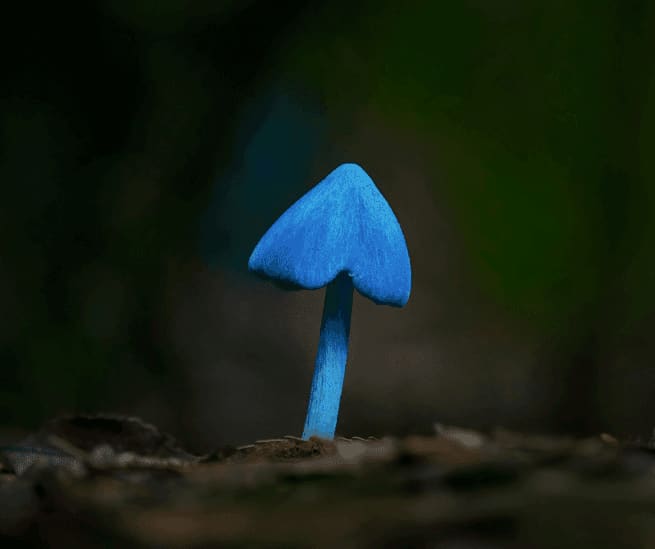
These adorable tiny blue mushrooms look like pointed hats for miniature gnomes. While these mushrooms are not known to be poisonous, they give off a strong, nasty smell in order to attract flies to help disperse their spores. They are native to New Zealand and India, and are named after New Zealand’s native kōkako bird, whose bright blue plume mimics this gorgeous fungi.
Indigo Milk Cap mushroom
Scientific name: Lactarius indigo

Surprisingly edible, this mushroom’s cap may be a muted light blue, but its gills reveal an underside of incredible royal blue. When cut, the mushroom oozes an indigo liquid that gradually turns green exposed to air. Native to southern and eastern North America, this blue pigment mushroom is especially prevalent in the Appalachian Mountains and along the Gulf of Mexico.
Violet Coral fungus
Scientific name: Clavaria zollingeri

Coral fungi live up to their name as they are shaped like long coral branches with bright purple and violet colorings. This mushroom is widely distributed around the world and can be found in coniferous woodlands as well as under oak and hickory trees. Eating coral mushrooms is not advised, as many species are extremely poisonous. Even the nontoxic ones typically cause stomach upsets and aren’t pleasant to taste.
Violet Webcap mushroom
Scientific name: Cortinarius violaceus

Cortinarius have a unique texture to their caps, and come in an array of purple, red, and blue hues. While their coloring can be deep and lovely, most of them are extremely poisonous. If ingested, they can cause acute tubulointerstitial nephritis, which can cause intense damage to the kidneys and immune system! They tend to grow in deciduous woodlands and occasionally under conifers with the right soil conditions.
Which colored mushrooms are poisonous?
This question can be tricky, as there aren’t many clear-cut rules to identifying poisonous mushrooms without identifying their exact species first. Generally, it’s best to avoid red mushrooms, as they are either extremely hallucinogenic or downright poisonous. Mushrooms with white gills are also good to avoid, as many poisonous mushrooms have this trait.
Overall, it’s best to make sure that you are 100% on a species before consuming a mushroom. Or, if you want to taste some new mushroom varieties, why not try learning how to grow your own?


